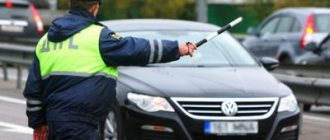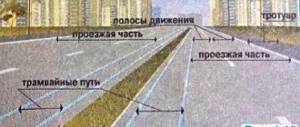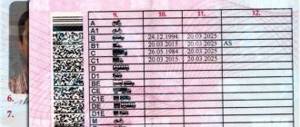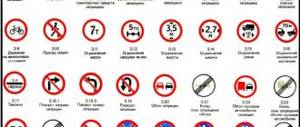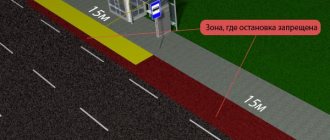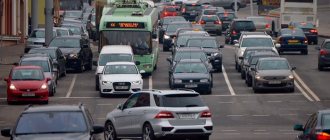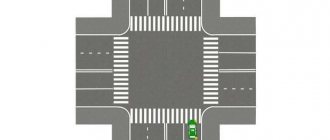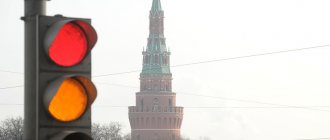| Number | Name | |||||
| 8.1.1 | Distance to objectThe distance from the sign to the beginning of the dangerous section, the place where the corresponding restriction is introduced, or a certain object (place) located ahead in the direction of travel is indicated. | |||||
| 8.1.2 | Distance to objectIndicates the distance from sign 2.4 to the intersection if sign 2.5 is installed immediately before the intersection. | |||||
| 8.1.3 | Distance to objectIndicates the distance to an object located off the road. | |||||
| 8.2.1 | Coverage areaIndicates the length of a dangerous section of the road, indicated by warning signs, or the coverage area of prohibitory and information signs. | |||||
| 8.2.2 — 8.2.6 | Coverage area8.2.2 Indicates the coverage area of prohibitory signs 3.27 - 3.30 8.2.3 Indicates the end of the coverage area of signs 3.27 - 3.30 8.2.4 Informs drivers that they are in the coverage area of signs 3.27 - 3.30 8.2.5, 8.2.6 Indicate the direction and coverage area of signs 3.27 - 3.30 when stopping or parking is prohibited along one side of the square, the facade of a building, etc. | |||||
| 8.3.1 — 8.3.3 | Directions for actionIndicate the direction of action of signs installed in front of the intersection or the direction of movement to designated objects located directly next to the road. | |||||
| 8.4.1 — 8.4.8 | Type of vehicleIndicate the direction of action of signs installed in front of the intersection or the direction of movement to designated objects located directly next to the road. | |||||
| 8.4.9 — 8.4.15 | In addition to the type of vehicleIndicate the type of vehicle that is not covered by the sign. Plate 8.4.14 does not apply the sign to vehicles used as passenger taxis. | |||||
| 8.5.1 | Saturday, Sunday and holidaysIndicate the days of the week during which the sign is valid. We discussed this plate in detail in a separate article. | |||||
| 8.5.2 | Work daysIndicate the days of the week during which the sign is valid. We discussed this plate in detail in a separate article. | |||||
| 8.5.3 | Days of the weekIndicate the days of the week during which the sign is valid. | |||||
| 8.5.4 | Time of actionIndicates the time of day during which the sign is valid. | |||||
| 8.5.5 — 8.5.7 | Time of actionIndicate the days of the week and time of day during which the sign is valid. | |||||
| 8.6.1 — 8.6.9 | Method of parking a vehiclePlate 8.6.1 indicates that all vehicles must be parked parallel to the edge of the roadway. Plates 8.6.2 - 8.6.9 indicate the method of parking cars and motorcycles in sidewalk parking. | |||||
| 8.7 | Parking with the engine not runningIndicates that in a parking lot marked with sign 6.4, parking of vehicles only with the engine not running is permitted. We discussed this sign in detail in a separate article. | |||||
| 8.8 | Paid servicesIndicates that services are provided for a fee only. We discussed this plate in detail in a separate article. | |||||
| 8.9 | Parking duration limitationIndicates the maximum duration of a vehicle's stay in a parking lot indicated by sign 6.4. | |||||
| 8.9.1 | Parking for parking permit holders onlyIndicates that only vehicles whose owners have a parking permit, obtained in accordance with the procedure established by the executive authorities of a constituent entity of the Russian Federation or local self-government bodies and valid within the territory whose boundaries are established by the relevant executive authorities, can be placed in the parking lot marked with sign 6.4. subject of the Russian Federation or local government bodies. | |||||
| 8.10 | Vehicle inspection areaIndicates that there is an overpass or inspection ditch on the site marked with sign 6.4 or 7.11. | |||||
| 8.11 | Maximum weight limitIndicates that the sign applies only to vehicles with a permissible maximum weight exceeding the maximum weight indicated on the plate. | |||||
| 8.12 | Dangerous roadsideWarns that going to the side of the road is dangerous due to repair work being carried out on it. Used with sign 1.25. | |||||
| 8.13 | Main road directionIndicates the direction of the main road at an intersection. | |||||
| 8.14 | LaneIndicates the traffic lane or bicycle lane covered by a sign or traffic light. | |||||
| 8.15 | Blind pedestriansIndicates that the pedestrian crossing is used by the blind. Used with signs 1.22, 5.19.1, 5.19.2 and traffic lights. | |||||
| 8.16 | Wet coatingIndicates that the sign applies to the period of time when the roadway surface is wet. | |||||
| 8.17 | Disabled peopleIndicates that the effect of sign 6.4 applies only to motorized wheelchairs and cars on which “Disabled” identification signs are installed. Read more about signs for disabled people here. | |||||
| 8.18 | Except for disabled peopleIndicates that the action of the signs does not apply to motorized wheelchairs and cars on which the “Disabled” identification signs are installed. | |||||
| 8.19 | Dangerous goods classIndicates the number of the class (classes) of dangerous goods according to GOST 19433-88. | |||||
| 8.20.1 — 8.20.2 | Vehicle bogie typeUsed with sign 3.12. Indicates the number of adjacent axles of the vehicle, for each of which the mass indicated on the sign is the maximum permissible. | |||||
| 8.21.1 — 8.21.3 | Type of route vehicleUsed with sign 6.4. Designate the parking area for vehicles at metro stations, bus (trolleybus) or tram stops, where a transfer to the appropriate type of transport is possible. | |||||
| 8.22.1 — 8.22.3 | LetThey indicate the obstacle and the direction to avoid it. Used with signs 4.2.1—4.2.3. | |||||
| 8.23 | Photo and video recordingUsed with signs 1.1, 1.2, 1.8, 1.22, 3.1-3.7, 3.18.1, 3.18.2, 3.19, 3.20, 3.22, 3.24, 3.27-3.30, 5.14, 5.21, 5.27 and 5.31, as well as with traffic lights. Indicates that in the coverage area of a road sign or on a given section of the road, administrative offenses can be recorded using automatic special technical means that have the functions of photography, filming and video recording, or by means of photography, filming and video recording. | |||||
| 8.24 | A tow truck is workingIndicates that a vehicle is being detained in the area of operation of road signs 3.27–3.30. We discussed this plate in detail in a separate article. | |||||
| 8.25 | Ecological class of the vehicleIndicates that the effect of signs 3.3 - 3.5, 3.18.1, 3.18.2 and 4.1.1 - 4.1.6 applies to motor vehicles whose environmental class indicated in the registration documents for these vehicles is lower than the environmental class indicated on the plate ; Indicates that the effect of signs 5.29 and 6.4 applies to motor vehicles, the environmental class of which, indicated in the registration documents for these vehicles, corresponds to the environmental class indicated on the plate, or is higher than the environmental class indicated on the plate. | |||||
Many drivers know that in addition to the main road signs, there are additional ones. They are not independent, i.e. work only in conjunction with others. Such signs limit or clarify the effect of the signs with which they are used.
What road signs look like for more information
Road signs with pictures and explanations can be found in the image above.
They indicate the coverage area of prohibiting signs, the distance to a dangerous turn, etc. Road symbols must be clearly visible over a long distance. The dimensions of the plates are determined by GOST. Available in four sizes:
1The first size, where the height is 30 cm and the width is 60.
2The second size, where the height is 35 cm and the width is 70.
3The third size, where the height is 45 cm and the width is 90.
general description
Additional traffic information signs create more comfortable and understandable driving conditions for drivers, i.e. increase safety. Thanks to such signs, you don’t have to guess about the length and distance of the territory. Every driver must be careful on the road, pay attention not only to the main signs, but also to the signs below with additional information.
Signs 8.23 and 8.24
What are additional information signs?
These are special signs, with their help you can clarify, expand, or reduce the scope of the signal with which the sign is installed.
In simple terms, symbols with additional information are not independent on their own, but “work” exclusively in tandem with other signals. Externally, they are a black drawing made on a white rectangular plate.
Reference. An exception to the rule is the index number 8.13. It is a white square with a black instruction on it.
@z34.1c-umi.ru
How to group
Many types of signs are used, which are formed into separate groups. This:
- Distance to object;
- coverage area;
- directions;
- type of vehicle;
- days of the week;
- time of action;
- method of parking the vehicle;
- parking and parking;
- blind pedestrians;
- type of route vehicle;
- Services;
- traffic lane (road surface, road direction, etc.).
Sign 8.5.6
If temporary road signs and permanent signs contradict each other, then drivers should be guided by temporary tables.
Additional information signs (plates)
Traffic regulations 2021, 2021 with online comments
Appendix 1 Traffic rules Road signs (according to GOST R 52289-2019 and GOST R 52290-2004)
Additional information signs (plates) clarify or limit the effect of the signs with which they are used.
| 8.1.1 “Distance to object.” Indicates the distance from the sign to the beginning of the dangerous section, the place where the corresponding restriction is introduced, or a specific object (place) located ahead in the direction of travel. |
Plates 8.1.1 are used with warning signs if they are installed at a distance other than that determined by the traffic rules.
With prohibition signs, plate 8.1.1 indicates the distance to the place where the restriction or prohibition is introduced.
Table 8.1.1 “Distance to object” can also be used with other groups of signs. For more details, see the article Signs “Distance to object”.
| 8.1.2 “Distance to object.” Indicates the distance from sign 2.4 to the intersection if sign 2.5 is installed immediately before the intersection. |
| 8.1.3, 8.1.4 “Distance to object”. Indicate the distance to an object located away from the road. |
| 8.2.1 "Area of Operation". Indicates the length of a dangerous section of the road, indicated by warning signs, or the coverage area of prohibitory signs, as well as signs 5.16, 6.2 and 6.4. |
Plate 8.2.1 “Area of Effect”, used with warning signs, informs only about the length of the dangerous area and does not provide any information about how many meters this danger awaits the driver.
Prohibitory signs applied with plate 8.2.1 come into effect directly at the installation site. The prohibition entered by the sign is valid for the length of the road indicated in the sign.
Information signs operate in a similar way if the 8.2.1 “Area of Action” plate is installed along with them. Signs are valid from the place of installation. For more details, see the article Zone and Direction of Action Signs.
| 8.2.2 - 8.2.6 “Coverage area”. 8.2.2 indicates the coverage area of prohibitory signs 3.27 - 3.30; 8.2.3 indicates the end of the coverage area of signs 3.27 - 3.30; 8.2.4 informs drivers that they are in the coverage area of signs 3.27 - 3.30; 8.2.5, 8.2.6 indicate the direction and coverage area of signs 3.27 - 3.30 when stopping or parking is prohibited along one side of the square, the facade of a building, etc. |
Signs (plates) 8.2.2 - 8.2.6 “Area of Action” are used only with signs 3.27 - 3.30. For more details, see the article Zone and Direction of Action Signs.
| 8.3.1 - 8.3.3 “Action directions”. Indicate the direction of action of signs installed in front of the intersection, or the direction of movement to designated objects located directly next to the road. |
Signs 8.3.1 - 8.3.3 “Directions of action” are used with signs 3.2 - 3.9, 5.3 and 1.32. For more details, see the article Zone and Direction of Action Signs.
| 8.4.1 - 8.4.8 “Type of vehicle”. Indicate the type of vehicle to which the sign applies. |
Plate 8.4.1 applies the sign to trucks, including those with a trailer, with a permissible maximum weight of more than 3.5 tons, plate 8.4.3 - to passenger cars, as well as trucks with a permissible maximum weight of up to 3.5 tons, plate 8.4.3.1 - for electric vehicles and hybrid vehicles that can be charged from an external source, plate 8.4.8 - for vehicles equipped with identification signs (information plates) “Dangerous goods”.
What do plates 8.4.1 - 8.4.8 mean? - in the article Plates “Type of vehicle”.
| 8.4.9 - 8.4.15 “Except for the type of vehicle . Indicate the type of vehicle that is not covered by the sign. |
Plate 8.4.14 does not apply the sign to vehicles used as passenger taxis.
What do plates 8.4.9 - 8.4.15 installed with signs mean in the example - in the article Plates “Type of vehicle”.
| 8.5.1 “Saturdays, Sundays and holidays” , 8.5.2 “Working days” , 8.5.3 “Days of the week” . Indicate the days of the week during which the sign is valid. |
More details about the days of the week can be found in the article Tablets 8.5.1 - 8.6.9.
| 8.5.4 “Validity time”. Indicates the time of day during which the sign is valid. |
| 8.5.5 - 8.5.7 “Action time”. Indicate the days of the week and time of day during which the sign is valid. |
More details about the duration of action can be found in the article Tables 8.5.1 - 8.6.9.
| 8.6.1 - 8.6.9 “Method of parking a vehicle.” 8.6.1 indicates that all vehicles must be parked parallel to the edge of the roadway; 8.6.2 - 8.6.9 indicate the method of parking cars and motorcycles in a sidewalk parking lot. |
Parking is defined by the Traffic Regulations as a deliberate cessation of traffic for a period of more than 5 minutes, if this is not related to the embarkation or disembarkation of passengers or the loading and unloading of goods (clause 1.2 of the Traffic Regulations, the term “Parking”). Sign 6.4 “Parking (parking space)” with plates 8.6.1-8.6.9 determine the method of parking the vehicle only when parked.
Stopping in the same places is allowed for any vehicles (clause 1.2 of the traffic rules, the term “Stop”). Signs The method for parking the vehicle is in the article Signs 8.5.1 - 8.6.9.
| 8.7 “Parking with the engine not running.” Indicates that in a parking lot marked with sign 6.4, parking of vehicles only with the engine not running is permitted. |
More details about sign 8.7 can be found in the article Tables 8.7 - 8.10.
| 8.8 “Paid services”. Indicates that services are provided for a fee only. |
More details about sign 8.8 can be found in the article Tables 8.7 - 8.10.
| 8.9.1 “Limitation of parking duration.” Indicates the maximum duration of a vehicle's stay in a parking lot indicated by sign 6.4. |
More details about sign 8.9 can be found in the article Tables 8.7 - 8.10.
| 8.9.2 “Parking only for holders of parking permits.” Indicates that only vehicles whose owners have a parking permit, obtained in accordance with the procedure established by the executive authorities of a constituent entity of the Russian Federation or local self-government bodies and valid within the territory whose boundaries are established by the relevant executive authorities, can be placed in the parking lot marked with sign 6.4. subject of the Russian Federation or local government bodies. |
A temporary (not officially approved) image of sign 8.9.1 is in the article Tablets 8.7 - 8.10.
| 8.9.3 “Parking for diplomatic vehicles only.” Indicates that only vehicles of accredited diplomatic missions, consular offices, international (interstate) organizations and representative offices of such organizations that have state registration plates used to designate such vehicles can be placed in a parking lot (parking space) marked with sign 6.4. |
A temporary (not officially approved) image of sign 8.9.2 is in the article Tablets 8.7 - 8.10.
| 8.10 “Place for inspection of vehicles.” Indicates that there is an overpass or inspection ditch on the site marked with sign 6.4 or 7.11. |
Tablet 8.10 is popularly nicknamed “Overpass”. For more details, see the article Tablets 8.7 - 8.10.
| 8.11 "Limitation of permissible maximum weight." Indicates that the sign applies only to vehicles with a permissible maximum weight exceeding the maximum weight indicated on the plate. |
More details about sign 8.11 can be found in the article Tablets 8.11 - 8.15.
| 8.12 “Dangerous roadside”. Warns that going to the side of the road is dangerous due to repair work being carried out on it. Used with sign 1.25. |
More details about sign 8.12 can be found in the article Tablets 8.11 - 8.15.
| 8.13 "Direction of the main road." Indicates the direction of the main road at an intersection. |
More details about sign 8.13 can be found in the article Tablets 8.11 - 8.15. Driving through intersections where the main road changes direction at the intersection - in the Main Road series of articles.
| 8.14 "Traffic lane". Indicates the traffic lane or bicycle lane covered by a sign or traffic light. |
More information about sign 8.14 can be found in the article Tablets 8.11 - 8.15.
| 8.15 “Blind pedestrians.” Indicates that the pedestrian crossing is used by the blind. Used with signs 1.22, 5.19.1, 5.19.2 and traffic lights. |
More details about sign 8.15 can be found in the article Tablets 8.11 - 8.15.
| 8.16 “Wet coating”. Indicates that the sign applies to the period of time when the roadway surface is wet. |
More details about sign 8.16 can be found in the article Tablets 8.16 - 8.20.
| 8.17 "Disabled people". Indicates that the effect of sign 6.4 applies only to motorized wheelchairs and cars on which the “Disabled” identification sign is installed. 8.18 “Except for disabled people.” Indicates that the sign does not apply to motorized wheelchairs and cars on which the “Disabled” identification sign is installed. |
For more details, see the article Tablets 8.16 - 8.20.
| 8.19 “Class of dangerous goods”. Indicates the number of the class (classes) of dangerous goods according to GOST 19433-88. |
More details about sign 8.19 can be found in the article Tables 8.16 - 8.20.
| 8.20.1, 8.20.2 “Vehicle bogie type.” Used with sign 3.12. Indicate the number of adjacent axles of the vehicle, for each of which the mass indicated on the sign is the maximum permissible. |
More information about signs 8.20 can be found in the article Tablets 8.16 - 8.20.
| 8.21.1 - 8.21.3 “Type of route vehicle.” Used with sign 6.4. They indicate where vehicles are parked at metro stations, bus (trolleybus) or tram stops, where transfer to the appropriate mode of transport is possible. |
More details about signs 8.21 can be found in the article Tablets 8.21 - 8.25.
| 8.22.1 - 8.22.3 "Obstacle". They indicate the obstacle and the direction to avoid it. Used with signs 4.2.1 - 4.2.3. |
More details about signs 8.22 can be found in the article Tablets 8.21 - 8.25.
| 8.23 “Photo and video recording.” Applicable with signs 1.1, 1.2, 1.8, 1.22, 1.35, 3.1 - 3.7, 3.18.1, 3.18.2, 3.19, 3.20, 3.22, 3.24, 3.27 - 3.30, 5.14, 5.21, 5.27 and 5.31, (from July 1 2018 years still 5.35 and 5.36) as well as with traffic lights. Indicates that in the coverage area of a road sign or on a given section of the road, administrative offenses can be recorded using automatic special technical means that have the functions of photography, filming and video recording, or by means of photography, filming and video recording. |
For more information about the “Photo and video recording” sign, see the article Plates 8.21 - 8.25.
| 8.24 “The tow truck is working.” Indicates that a vehicle is being detained in the coverage area of road signs 3.27 - 3.30. |
For more information about the “Tow Truck Operating” sign, see the article Plates 8.21 - 8.25.
Table 8.25 “Ecological class of the vehicle.” Indicates that signs 3.3 - 3.5, 3.18.1, 3.18.2 and 4.1.1 - 4.1.6 apply to motor vehicles:
Indicates that signs 5.29 and 6.4 apply to motor vehicles:
|
More information about the “Ecological class of vehicles” sign can be found in the article Plates 8.21 - 8.25. About environmental classes in traffic rules - see the article Changes in traffic rules from July 1, 2021.
Plates are placed directly under the sign with which they are used. Plates 8.2.2 - 8.2.4, 8.13, when signs are located above the roadway, shoulder or sidewalk, are placed on the side of the sign.
The yellow background on signs 1.8, 1.15, 1.16, 1.18 - 1.21, 1.33, 2.6, 3.11 - 3.16, 3.18.1 - 3.25 installed in road work areas means that these signs are temporary .
In cases where the meanings of temporary road signs and permanent road signs contradict each other, drivers should be guided by the temporary signs.
Note. Signs in accordance with GOST 10807-78 that are in use are valid until they are replaced in the prescribed manner with signs in accordance with GOST R 52290-2004.
